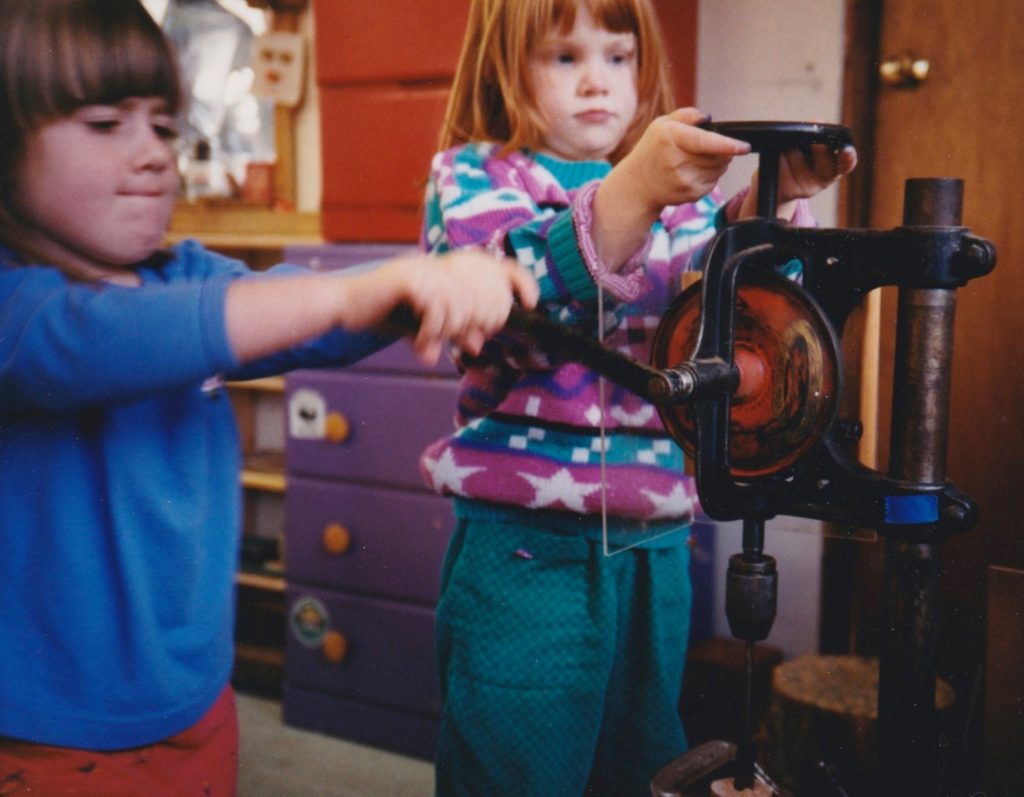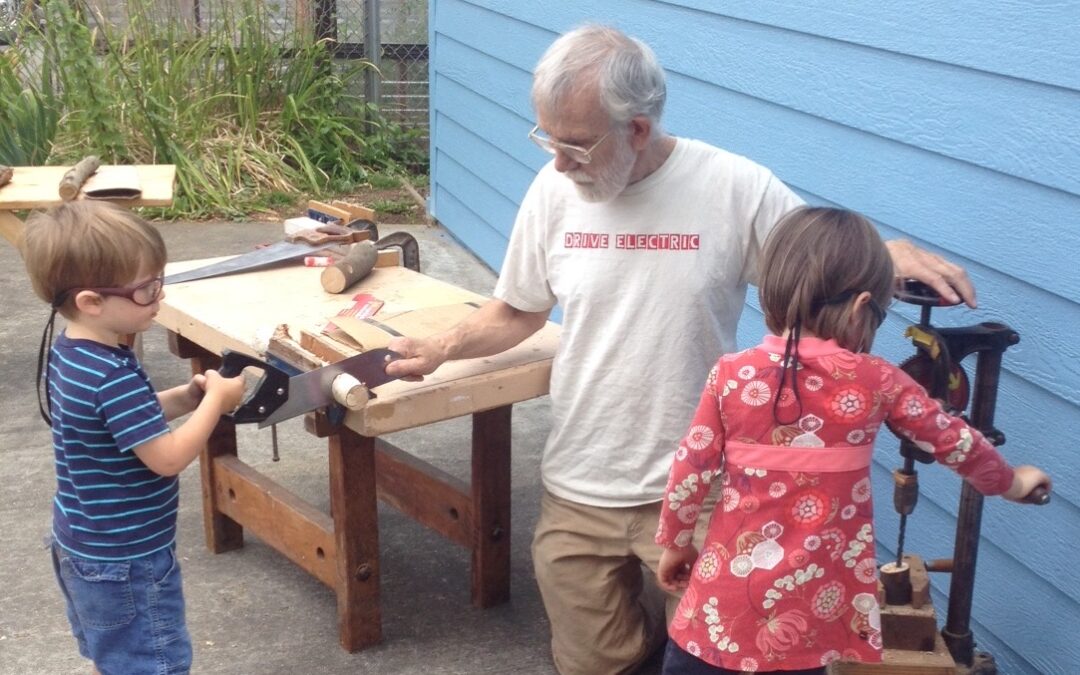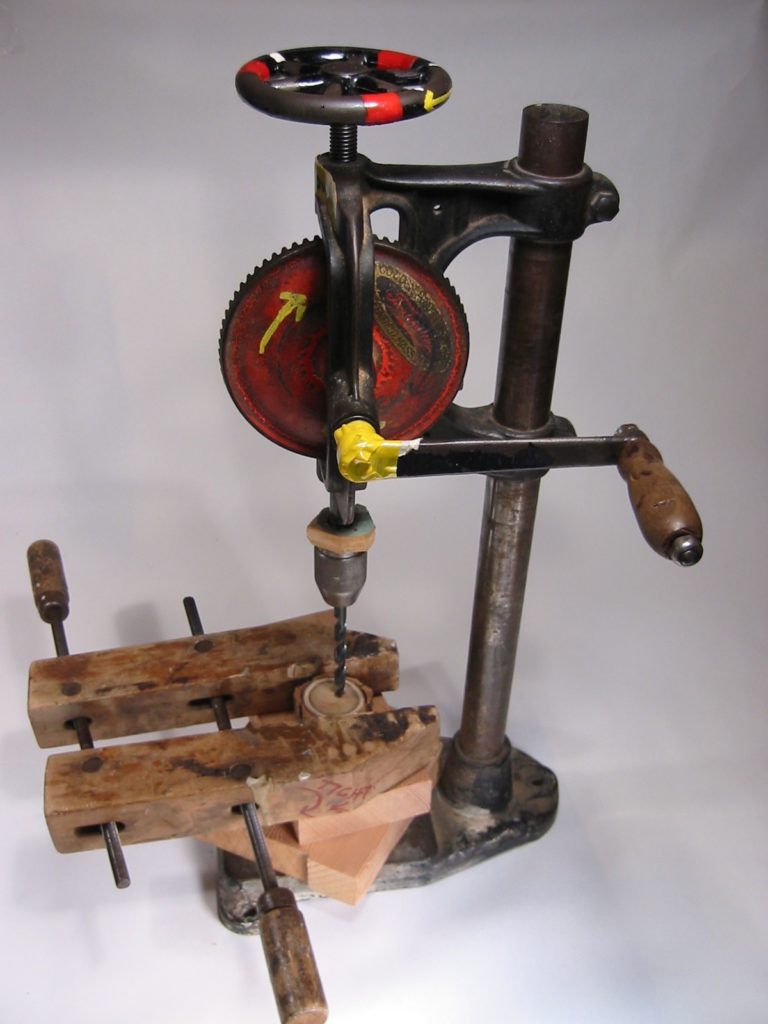Kids and the Hand Operated Drill Press
Here is a video of a 4th grader using the drill press. 3rd or 4th graders learn quickly, younger kids take longer.
I found a hand-operated drill press at an antique tool sale. It makes many drilling operations easier and safer for kids. With it, a child doesn’t have to support the weight of the drill or hold it straight. The feed mechanism allows her to apply more pressure to the bit. Kids enjoy using it and it makes more projects possible.
Many types of hand-operated drill presses were made in the early 1900s. The more complicated and sophisticated ones, with a flywheel and automatic feed mechanisms, are not appropriate for children. Mine is basically a big hand egg beater type drill, held in a stand, with a screw mechanism to raise or lower the bit. Mount it on a bench 12″ high so the handle will be at about shoulder level for a child. I’ve spent quite a bit of time trying to figure out how to make one of these from a big breast drill but have been unsuccessful so far. Maybe someone out there has an idea.
The hand operated drill press
The crank handle turns clockwise to rotate the bit. The top wheel turns the direction of the arrow to move the bit down. The wood is held still by a clamp. Blocks under the wood adjust the work to the correct height.
Here is how to use it. Install the proper bit in the same way as for the hand drill. Get the wood ready to be drilled by raising the bit up as far as it will go and blocking up underneath the wood, if necessary, to get it up close to the bit. Hold the wood so it won’t move. Best to clamp small pieces as shown above. Large wood will spin a half turn or so until it hits the pipe supporting the drill and stops. Now you’re ready to begin the actual drilling.
Using the drill press is a little like rubbing your stomach and patting your head. There are two controls, one for each hand, and they have different motions. A handle on the right, like the one on the hand drill, rotates the drill bit. A wheel on top of the drill press moves the bit either up or down. To drill a hole, both controls need to be turned clockwise at the same time. The right hand needs to keep the drill turning at a comfortable speed while the left hand feeds the bit into the wood at the appropriate rate—slow for large holes and faster for smaller ones. Often kids have trouble turning both weeks at once. Both wheels should be marked with a clockwise pointing arrow as a reminder of the correct direction to turn. Nearly everyone turns the top wheel down too fast, which jams the bit into the wood and stops it from rotating.
Teaching kids how to use this tool is a classic example of words not really helping much. At first I would tell a child to slow the top wheel but it seldom registers. Sometimes I’ll slow the top wheel with my own hand and they learn from that. Or I might let them go ahead and jam the bit (if its a big bit) into the wood stopping the drill. Another approach is to pace them with a little chant, “one, two, quarter turn.” This means turn the crank handle once around, around again, and then turn the down feed (top wheel) a quarter turn. If a child still has trouble, I’ll suggest he put one hand behind his back and use one hand for both operations.

Two kindergarteners working together on the drill press.
The same chant sometimes helps here, too. It takes practice and often I’ll have to come back and help 3 or 4 times. Sometimes two children can work together one operating the down feed and the other rotating the bit. After the hole is finished, the bit must still be removed from the hole. First raise the wood up (by turning the top wheel counterclockwise) until there is plenty of room underneath it. Then rotate the drill (same direction as for drilling) and push down on the wood at the same time. Kids (or adults) intuitively want to reverse the drill bit to get it out but this will often loosen the bit in the chuck so it gets stuck in the wood. Kids will break small drill bits so I learned to use small nails instead of bits which were easily replaceable.
I bought this many years ago and hundreds, of kids have used it. If kids can drill bigger and straighter holes it allows them to build quite a few more projects. They like the challenge of learning to use it and are also proud of their new found competence. Often they want to demonstrate how to use the drill press to their parents.
••••


Love this. Wish I’d had one when I was a kid. I have a very similar drill press with an automatic feed system. Do you have any idea who made this drill press?
Barry,
No idea who made it but its old, maybe fro the 1920’s. I have spent way too much time trying to figure out how to take one of those old breast drills and mount it in a stand but to no avail.